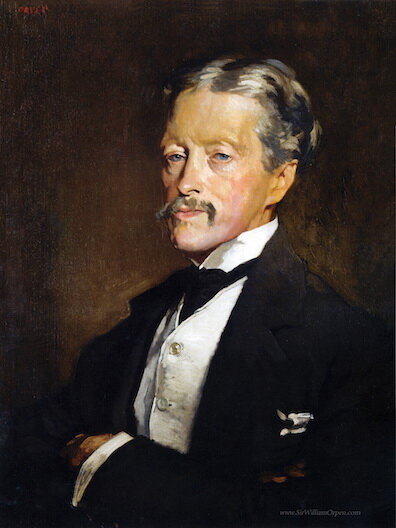The Joyce Project : Ulysses : Lord Iveagh and Lord Ardilaun
Lord Iveagh and Lord Ardilaun
Lord
Iveagh and Lord Ardilaun
In Brief
The two rich men that Bloom thinks of in connection with
"porter" in Lotus Eaters, "Lord Iveagh" and "lord
Ardilaun," were partners in a large Dublin brewery. Just how
large and how rich may be imagined by anyone who knows their
non-noble names: Edward Cecil Guinness and Arthur Edward
Guinness. Reference is made to their brewing prowess in Cyclops,
and in the jumble of slang at the end of Oxen of the Sun
someone simply orders "Two Ardilauns," echoed by someone
else's "Same here."
Read More
Arthur and Edward were the first and third sons,
respectively, of Sir Benjamin Guinness, who was the grandson
of the Guinness who founded Dublin's most famous brewery.
Arthur, who was named after his great-grandfather, sold his
share of the business to his brother in 1876. In 1880 he was
made Baron Ardilaun of Ashford Castle in County
Galway, where he became a great landlord owning 33,000 acres.
Edward, the younger brother, oversaw the transformation of
what was now his business into a public company in 1886 and
became the richest man in Ireland by virtue of his stock
holdings. In addition to being the 1st Baronet of Ashford and
the baronet of Castle Knock in County Dublin, and much later
Viscount Selveden in England's Suffolk County, in 1891 he was
made Baron Iveagh of Iveagh in County Down, a newly
created peerage.
Both Anglo-Irish brothers put their fabulous wealth to
philanthropic use. Edward established charitable trusts to
clear tenements and build affordable housing for the poor in
Dublin and London. He also funded institutes for medical
research in England, contributed money for the construction of
buildings at both of Dublin universities, and donated land for
the Iveagh Gardens south of St. Stephen's Green, now a public
park. Arthur donated money to restore Marsh's Library and to
expand the Coombe Lying-in
Hospital. He also aided a movement to conserve the wild
lands around Killarney and spearheaded the project of
converting St. Stephen's Green from a blighted field into an
elegant urban park. That park now contains busts and larger
statues of various Irish luminaries, and one dedicated to Lord
Ardilaun's memory stands on the western edge.
Bloom does not think of the philanthrophic enterprises but
only of the wealth: "Lord Iveagh once cashed a sevenfigure
cheque for a million in the bank of Ireland. Shows you the
money to be made out of porter." Of Arthur Guinness he
thinks, "Still the other brother lord Ardilaun has to
change his shirt four times a day, they say. Skin breeds
lice or vermin." Commenting on this strange report,
Gifford notes that in a letter Joyce described Ardilaun as
"morose and charitable." There is evidence of a morose
temperament. In 2018 an RTE documentary observed that when Sir
Hugh Lane asked him to contribute money to the modern art
gallery he wanted to establish on the western edge of St.
Stephen's Green (the same gallery that meant so much to W. B.
Yeats), Ardilaun replied, "Are you mad? I will not have myself
stand sentry to a picture palace like some giddy huckster." As
far as I know, however, there is no evidence of his
biliousness having caused skin problems.
Joyce returned to the Guinness brothers in Cyclops,
augmenting their names with beer barrel stoppers: "Terence
O'Ryan heard him and straightway brought him a crystal cup
full of the foamy ebon ale which the noble twin brothers
Bungiveagh and Bungardilaun brew ever in their divine
alevats, cunning as the sons of deathless Leda. For they
garner the succulent berries of the hop and mass and sift and
bruise and brew them and they mix therewith sour juices and
bring the must to the sacred fire and cease not night or day
from their toil, those cunning brothers, lords of the vat."

